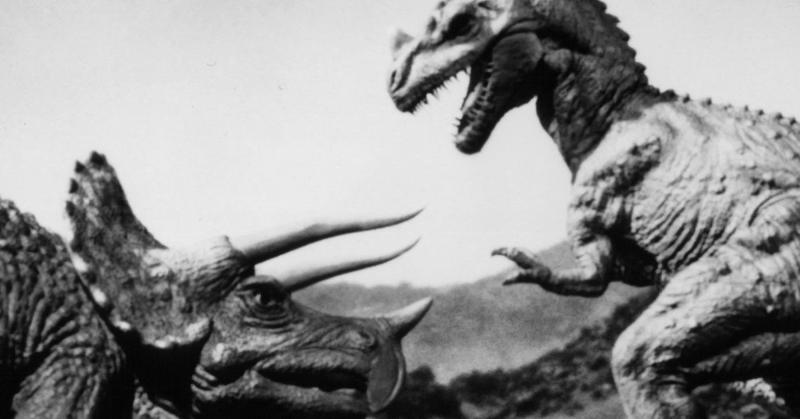How Two Fighting Dinosaurs Sparked A 'Renaissance' In 1971
By | March 4, 2019

Humans' understanding of dinosaurs in the mid 20th century was flawed -- but then, in 1971, we found the "Fighting Dinosaurs," and the "Dinosaur Renaissance" began gaining greater acceptance. Our assumptions about dinosaurs -- that they were essentially slow and stupid -- were suddenly, graphically, shown to be false.
Paleontologists from Poland and Mongolia working in the Gobi Desert unearthed what would turn out to be a pivotal discovery in 1971: the skeletal remains of two different dinosaurs locked in mortal combat. The discovery became known as the Fighting Dinosaurs and offered proof of some of the new theories that were emerging during the so-called Dinosaur Renaissance of the 1960s and 1970s. It was during this time that scientists were learning that dinosaurs were not the simple, dim-witted, sluggish, cold-blooded creatures that were too stupid to win Darwin’s survival of the fittest game, but were, in fact, complex, speedy, intelligent, and warm-blooded. Still, it took a few decades before the public opinion shifted on the prehistoric beasts, paving the way for the more-realistic depiction of dinosaurs in The Land Before Time and Jurassic Park.
Mad, Angry Dinosaurs?

Prior to the Dinosaur Renaissance, much of what researched viewed as accepted facts about dinosaurs were based on theories and discoveries from 100 to 150 years before. In schools, children were not taught much about dinosaurs and what was being taught was outdated erroneous information. The first scientific discovery of a dinosaur was in 1824 and shortly afterward, the term Dinosaur, meaning "terrible lizard," was coined. In this case, however, the word “terrible” was meant to represent the enormous size of the newly-discovered beasts, not the ferociousness of them. When Charles Darwin’s theory of evolution was published in 1859, scientists applied the concept to the demise of the dinosaurs and pointed out that the large lizards were probably slow, clumsy, dumb, and ill-equipped to survive, explaining why they went extinct while mammals flourished. Most experts of the time agreed that, despite the name “terrible,” dinosaurs were not effective hunters due to their size. The 1971 discovery of a plant-eating dinosaur and a meat-eating dinosaur battling each other showed that dinosaurs could be fierce, aggressive creatures.
Dinosaurs Got A Bad Rap In Films

Even before the start of the Dinosaur Renaissance, Hollywood found that dinosaur movies were a popular genre. Some films attempted to show realistic dinosaurs, like the 1960s The Lost World. Others, like 1966's One Million Years B.C., were more interested in showing scantily-clad cave women than. Museum exhibits showed the 1970 stop-motion documentary Dinosaurs: The Terrible Lizards that was acclaimed for its portrayal of the prehistoric animals, yet was still inaccurate.
Movie Dinosaurs Were Not Accurate

Most of the dinosaur movies, from 1925s The Lost World to 1965s Voyage to the Prehistoric Planet, were riddled with inaccuracies. Directors and set designers invented their own dinosaurs instead of patterning them after actual dinosaur species. The movements and stances of the animals were not accurate. Lastly, the dinosaurs were cast as villains in the movies -- villains that threatened early cave men and scantily-clad cavewomen. We know now that humans emerged long after the extinction of the dinosaurs.
The Gobi Desert Find Help Spark Renewed Interest In Dinosaurs

Emerging scientific theories in the late 1960s, coupled with the discovery of the Fighting Dinosaurs in 1971, sparked renewed interest in dinosaurs from a new generation of paleontologists who were not afraid to challenge the century-old conventional beliefs. Spearheading this drive were two scientists, John Ostrom, and Robert Bakker. They popularized the ideas that dinosaurs were warm-blooded and intelligent, that modern-day birds evolved from dinosaurs, and the dinosaurs did not go extinct because they were ill-suited for life. Schoolchildren in the 1970s, however, were still taught that dinosaurs were big and dumb. It took a while before the public perception of dinosaurs caught up to the scientists' change in thinking.
The Dinosaur Renaissance Shifted Views

While exciting new discoveries were being made and new theories were being presented, schoolchildren and the general public were still being told the old, outdated views about dinosaurs. Paleontologists were learning that there were numerous species of dinosaurs and that they had a complex social order, means of communication, and nurtured their young. It was also during this time that geologists found evidence of a massive meteor strike that coincided with the mass extinction of the dinosaur, leading to the idea that the once-mighty dinosaurs did not die out due to their own ineptitude, but due to a natural disaster.
TV's 'Land of the Lost'

From 1974 to 1977, television audiences tuned in to watch the Marshall family who were trapped in a prehistoric time period on Land of the Lost. Although the family encountered the Sleestaks and Pakuni, humanoid species that were depicted as intelligent, the show’s dinosaurs were still portrayed as dim-witted and clumsy. Movement, appearance, and behavior of the dinosaurs did not reflect the newest scientific findings.
The Animated 'Land Before Time' Was More Realistic

Believe it or not, the 1988 animated movie, Land Before Time, created by Don Bluth, Steven Spielberg, and George Lucas, is credited with being the first movie to show accurate stance and movement of the dinosaur species, moving away from lizard-like movements to mammal-like movements. It seems to be the first time that filmmakers consulted the actual scientific understanding of dinosaurs, and used it in their movie.
The Realism Of 'Jurassic Park' Made It All The More Popular

In 1993, Jurassic Park was released. For the first time, dinosaurs were shown as quick, warm-blooded, highly-intelligent creatures. They were shown working together and communicating with each other. They were also shown as territorial and willing to fight off trespassers, just as the 1971 Gobi Desert expedition found twenty-two years earlier. Jurassic Park is credited with creating public awareness about the Dinosaur Renaissance and the new dinosaur theories that this movement produced.
